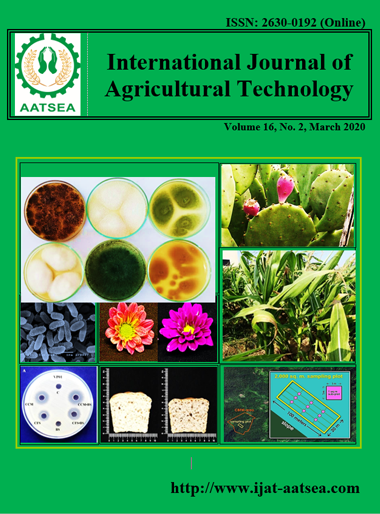The usage of rice bran flour and pea protein in pork patties and pork meatballs
Main Article Content
Abstract
Result found that the higher amount of extenders leading to higher the cooking yield, moisture retention and fat retention. Whereas, the diameter reduction and juiciness were decreased. The texture evaluation factors of all treatments were higher than the control treatment (p<0.05). For the color parameters, increased in pea protein caused the lightness, redness, yellowness, and protein content of the product to rise. The increase of rice bran flour caused fiber, ash, and carbohydrate to rise, but the lightness reduces. In addition, using rice bran flour and pea protein can reduce fat content. Sensory evaluation suggested that using rice bran flour and pea protein at 5% w/w in pork patties and pork meatballs had an overall acceptability similarly to the control. In conclusion, at 5% w/w or below each, rice bran flour and pea protein were suitable as extenders for pork patties and pork meatballs.
Article Details

This work is licensed under a Creative Commons Attribution-NonCommercial-NoDerivatives 4.0 International License.
References
AHA (American Heart Association) (1986). Dietary guidelines for healthy adult Americans. Circulation, 74:1465-1475.
AOAC (1997). Official Method of Analysis. 16th ed. The Association of Official Analytical Chemists, Arlington, Virginia.
Chandi, G. K. and Sogi, D. S. (2007). Functional properties of rice bran protein concentrates. Journal of Food Engineering, 79:592-597.
Choi, Y. S., Jeong, J. Y., Choi, J. H., Han, D. J., Kim, H. Y., Lee, M. A., Kim, H. W., Paik, H. D. and Kim, C. J. (2008). Effects of dietary fiber from rice bran on the quality characteristics of emulsion type sausages. Korean Journal of Food Science Animal Resource, 28:14-20.
Choi, Y. S., Choi, J. H., Han, D. J., Kim, H. Y., Lee, M. A., Kim, H. W., Jeong, J. Y. and Kim, C. J. (2009). Characteristics of low-fat meat emulsion systems with pork fat replaced by vegetable oils and rice bran fiber. Meat Science, 82:266-271.
Choi, Y. S., Choi, J. H., Han, D. J., Kim, H. Y., Lee, M. A., Kim, H. W., Jeong, J. Y. and Kim, C. J. (2010). Effects of replacing pork back fat with vegetable oils and rice bran fiber on the quality of reduced-fat frankfurters. Meat Science, 84:557-563.
El-Magoli, S. B., Laroia, S. and Hansen, P. T. M. (1996). Flavour and texture characteristics of low fat ground beef patties formulated with whey protein concentrate. Meat Science, 42:179-193.
Gao, X., Zhang, W. and Zhou, G. (2014). Effect of glutinious rice flour on the physiochemical and sensory qualities of ground pork patties. LWT - Food Science and Technology, 58:135-141.
Gujral, H. S., Kaur, A., Singh, N. and Sodhi, N. S. (2002). Effect of liquid whole egg, fat and textured soy protein on the textural and cooking properties of raw and baked patties from goat meat. Journal of Food Engineering, 53:377-385.
Hu, G. and Yu, W. (2015). Effect of hemicellulose from rice bran on low fat meatballs chemical and functional properties. Food Chemistry, 186:239-243.
Huang, S. C., Shiau, C. Y., Liu, T. E., Chub, C. L. and Hwang, D. F. (2005). Effects of rice bran on sensory and physico-chemical properties of emulsified pork meatballs. Meat Science, 70:613-619.
Jeong, J. Y., Lee, E. S., Choi, J. H., Lee, J. Y., Kim, J. M., Min, S. G., Chae, Y. C. and Kim, C. J. (2007). Variability in temperature distribution and cooking properties of ground pork patties containing different fat leveland with/without salt cooked by microwave energy. Meat Science, 75:415-422.
Khalil, A. H. (2000). Quality characteristics of low-fat beef patties formulated with modified corn starch and water. Food Chemistry, 68:61-68.
Osen, R., Toelstede, S., Wild, F., Eisner, P. and Weisz, U. S. (2014). High moisture extrusion cooking of pea protein isolates: Raw material characteristics, extruder responses, and texture properties. Journal of Food Engineering, 127:67-74.
Pietrasik, Z. and Janz, J. A. M. (2010). Utilization of pea flour, starch-rich and fiber-rich fractions in low fat bologna. Food research international, 43:602-608.
Reinkensmeier, A., Bußler, S., Schlüter, O., Rohn, S. and Rawel, H. M. (2015). Characterization of individual proteins in pea protein isolates and air classified samples. Food research international, 76:160-167.
Serdaroğlu, M. (2006). Improving low fat meatball characteristics by adding whey powder. Meat Science, 72:155-163.
Serdaroğlu, M. and Değirmencioğlu, Ö. (2004). Effects of fat level (5%, 10%, 20%) and corn flour (0%, 2%, 4%) on some properties of Turkish type meatballs (koefte). Meat Science, 68:291-296.
Sosulski, F. W. and McCurdy, A. R. (1987). Functionality of flours, protein fractions and isolates from field peas and faba bean. Journal of Food Science, 52:1010-1014.
Tömösközi, S., Lásztity, R., Haraszi, R. and Baticz, O. (2001). Isolation and study of the functional properties of pea protiens. Nahrung/Food, 45:379-401.
Ulu, H. (2006). Effects of carrageenam and guar gum on the cooking and textual properties of low fat meatballs. Food Chemistry, 95:600-605.
Vaisey, M., Tassos, L., McDonald, B. E. and Youngs, C. G. (1975). Performance of fababean and field pea protein concentrates as ground beef extenders. Canadian Institute of Food Science and Technology Journal, 8:74-78.
Warriss, P. D., (2000). Meat science: An introductory text, CABI Publishing, Wallingford, pp. 37-65.


